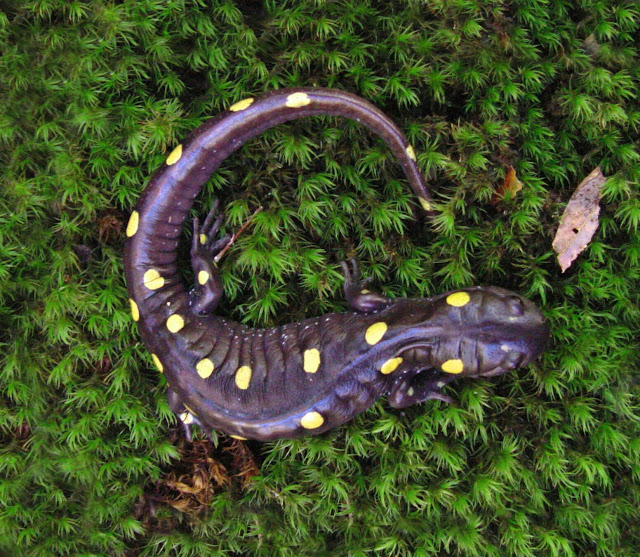Nature Notes from Greg Greer: Storms, Spotted Salamanders and Urban Amphibians
 |
| Spotted Salamanders usual breed by early March in Atlanta — but they have still been reproductive here in April, according to to Greg Greer, accomplished Atlanta-area herpetologist. |
Good morning everyone,
I hope that everyone faired well through yesterdays amazing weather event. At my place in Marietta, I received just a tad over 4” of rain. It was amazing how constant the sever weather threat lasted and tremendous lightening. A fair amount of hail and lots of rain. I wanted to take advantage of an educational moment in regard to the weather.
 |
| A female Spotted Salamander (Ambystoma maculatum) depositing eggs on a submerged branch. |
In regards to the storms. There is a major ecological benefit to lightening strikes. Most people fear them but without lightening, the earth’s ecosystems would turn “belly up”. Lightening accounts for a tremendous amount of available nitrogen to plants. Nitrogen is free lofted in the atmosphere but not usable to plants until it comes into contact with lighting. We do have nitrogen fixing plants….the legumes (Pea family) but certainly they only account for a certain amount of nitrogen and basically only in the area the legumes grow. So, planet wide, lightening is responsible for the nitrogen cycle crucial to life on planet Earth.
 |
| In the middle of this image is a submerged Spotted Salamander egg mass — detected by our MAAMP surveys right in midtown! |
Also, just after the last storms in Marietta, around 11 pm, I went out to my pond and spent over an hour observing what the weather had triggered. A synchronized migration of spotted salamanders had moved into the pond during the heaviest rains. I actually had thought this year would be a non-productive year for spotted salamanders as they typically move into ponds and wetlands in Feb, or early March. None this year so they are extremely late. Possibly they were really deep in the soil after the extreme drought of late summer and fall of last year. So, it took torrential rains to bring them up. Of course that is a guess. Anyway, both males and females moved at the same time. Usually males arrive on one rain, deposit spermatophores and then the females move one a second rain. Males entice the females totheir packet of genetic material, it is picked up in the cloaca of the female and thus fertilization takes place. Typically in the frigid water of winter. The water is already warm, so eggs being deposited now will incubate extremely quickly as warm water temperatures accelerate the egg growth.
Also, Green frogs were abundant in the pond. There were good numbers of leopard frog egg masses from their breeding about 2 weeks ago. One very large male bullfrog emerged last night fro.mn the pond bottom where he had spent the winter. He was thin and very hungry. I observed him consume two large green frog tadpoles and one Gambusia (mosquito fish)
Another appearance was by a very large Midland Water Snake. One of the largest I have seen in recent years. A good 3+ footer. He was checking out the edges looking for frogs to eat. He probably will not last long as I again have red-shouldered hawks nesting in my back yard and when that occurs, I lose all water snakes and many of the large frogs to hawk predation. They are very effective predators of the wetlands.
Anyway, you are welcome to share any of this with your students. I know children typically are frightened by storms but there is a bright side to them in regards to nature.
Best Regards,
Greg
 |
| Developing Spotted Salamander embryos. Symbiotic algae inside the eggs provide additional oxygen for the developing embryos while feeding on the waste material. |



Comments
Post a Comment